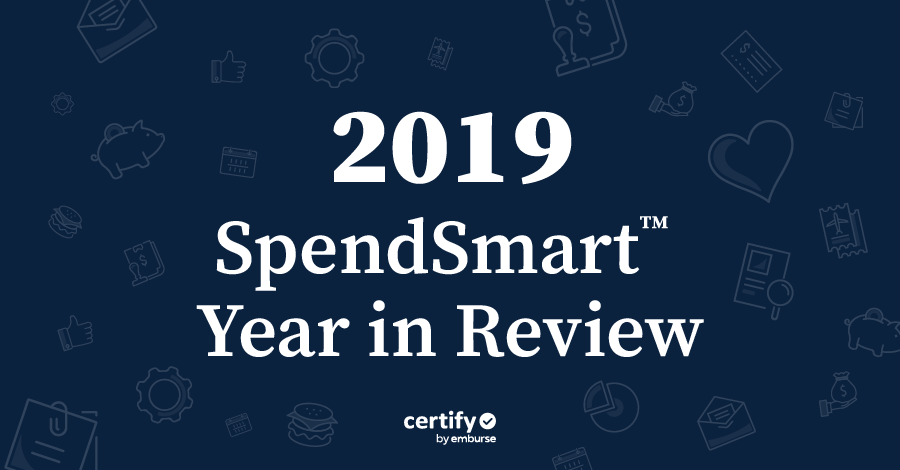The tallies are in and Certify’s annual summary of travel and expense trends is ready to review. We processed more than $5.1B in travel expense transactions last year, and the data uncovered some interesting shifts in buying behavior. The 2019 SpendSmart™ Year in Review aggregates data from those user transactions to present the leading expense categories, most expensed brands, and user ratings of the brands they rely on most.
From company lunches to scooter rentals, here are some highlights from last year’s data.
Ride hailing drives forward
The most notable trend comes from our benchmarks of T&E categories. Meals have been the most expensed category since 2015. That changed in 2019, as ride hailing services (Uber, Lyft, taxis) made up 17.5% of all transactions processed. It was enough to move the ride hailing category into the top spot. Meals, now pushed into second, accounted for 16.8%.
Rounding out the top five: airfare came in third with 13.1%, miscellaneous expenses at 12%, and fuel receipts at 11.4%.
Those same top categories mostly reflected measured increases in the average expense cost. Some were subtle. Others, not so subtle. Ride-hailing transactions averaged $24.86, an increase of $0.60 compared with 2018.
Meals increased by $7.01 to an average of $39.09. Users’ miscellaneous expenses fell by $4.80 to $115.50. The largest change in 2019 came from airfare, which jumped $30.75 to an average transaction cost of $308.40.
Uber maintains their lead
Amazon, Delta, Lyft, Starbucks, and Uber were recognized as 2019’s most expensed brands. At the front of the pack, Uber accounted for 12.6% of all transactions—nearly tripling its lead over Amazon in the number two spot with 4.9%. Starbucks, Lyft, and Delta populated the rest of the top five in that order.
Brand preferences by category and rating
Not much changed in terms of the most expensed vendors by category since our 2018 Year in Review report. One exception came from the hotel category. Marriott overtook Hampton Inn as the most expensed lodging provider in 2019 with 16.8% of transactions. Parallel to the most expensed data, user ratings for the vendor services expensed reflected a preference for convenience, quality, and price.
The top choices for most expensed and best-rated brands from each major category were:
-
Restaurants
-
Most expensed: Starbucks
-
Highest rated: Chick-Fil-A
-
Hotel
-
Most expensed: Marriott
-
Highest rated: Marriott
-
Car rental
-
Most expensed: National Car Rental
-
Highest rated: National Car Rental
-
Ride hailing
-
Most expensed: Uber
-
Highest rated: Lyft
-
Airfare
-
Most expensed: Delta
-
Highest rated: Southwest Airlines
My ride’s here
When moving around town, 2019 business travelers placed a premium on convenience. Ride hailing companies saw small increases over 2018’s receipt counts, and once again, overshadowed traditional taxis. Here’s how Uber, Lyft, and taxis fared for brand choice, average cost per ride, and average user rating
Rental cars remain important additions to a business traveler’s arsenal. National Car Rental took the top spot for the most expensed car rental brand in 2019 with 36.8% of transactions. It came in third for average expensed cost ($187.61) and first for average user rating.
Business travelers preferring more fresh air from their ground transportation opted for scooter rentals as a cost-saving kick to the usual ride hailing alternatives. With 50% of receipts expensed and an average per ride cost of $6.88, Lime was the preferred scooter rental brand.
Dining in via delivery
As they shift away from dining out, organizations and their traveling employees opted for the comfort of a warm meal delivered to their offices and hotel rooms. That trend was made clear as the meal delivery expense category plated up an 86% growth over 2018’s tally.
In order of favorite brands, DoorDash took top honors with nearly 30% of expenses submitted. Seamless, the fifth-place finisher, accounted for 5.3%. Though at the bottom of the top five, Seamless order costs led with an average of $86.09 and a user rating of 4.8.
2019 turned out to be another year of T&E disruption as some new expense options were favored over standards from the past. Will we see a different category surge ahead in 2020? The data will tell us throughout the upcoming year
____
How did travel and expenses at your company compare with this year’s benchmarks? Download your copy of the 2019 SpendSmart™ Year in Review infographic to compare, and for more insights into T&E trends.
